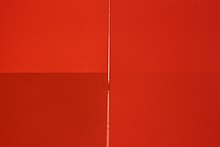Hiding power
The ability of a paint or varnish to cover the substrate is known as its opacity . In English, the terms "hiding power" or "spreading rate" are common. Terms like opacity or opacity should be avoided. The term contrast ratio is sometimes used.
properties
The lower the hiding power, the more difficult it is for a coating to cover up color differences. White paint with high hiding power is called opaque white ; one of the earliest pigments used for this was white lead . However, the opacity required for tinting also depends on the type of background. Lighter and more subtle colors are easier to "drown out" than dark and intense ones. Knowing the opacity is important, for example, to determine whether an existing painting can be covered with a new color.
Varnishes, oil paints or other professional paints usually have a higher hiding power than "do-it-yourself" paints such as watercolors. The selection of pigments is a decisive criterion for a high hiding power. Inorganic pigments, which scatter more strongly due to their high refractive index , usually have a higher hiding power than organic pigments. Due to their low refractive index, these scatter only weakly and are therefore usually combined with inorganic pigments.
Measurement method
The hiding power is determined qualitatively by applying a layer of paint of a defined thickness to a high-contrast background (usually black and white from a contrast card ). The hiding power is determined quantitatively by measuring the color difference between the free and the color-covered surface after drying or curing . A method for measuring the contrast ratio for interior dispersion paints is specified in EN 13300 .
The covering layer thickness of paints and varnishes is determined by producing coatings of different thicknesses. The layer thickness above which the coloristic properties no longer change is considered to be opaque. Coating in the wedge is also possible if it is possible to measure accurately. These limits were specified in DIN 55987 and in ASTM D 2805-70, but not identical. According to DIN 55987, for example, a maximum overall color difference is defined as opaque. This applies if the system was applied over a black ( reflectance value ) and white background ( ). According to ASTM D 2805-70, the ratio of the standard color value Y over black and white must be greater than or equal to 0.98. The use of only one standard color value instead of the total color difference does not sufficiently take into account differences between different color tone areas.
particularities
Dry hiding effect
In cheap white interior emulsion paints, an inorganic filler such as chalk or barium sulfate is often used in very high concentrations to increase the hiding power instead of titanium dioxide . In addition to the interfaces between binder and pigment and filler, the high concentration also creates interfaces between air and pigment and filler. In contrast to the relatively small difference in the refractive indices of the binder and filler, the difference in the refractive indices of air and filler is large enough to appear white, which in turn contributes to the hiding power.
Hiding power of organic pigments
Due to their relatively small particle size, organic pigments only cover through absorption. Since their color effect is created through selective absorption, organic colored pigments inevitably have a limited (color-dependent) hiding power. However, pigment black absorbs in the entire visible spectrum , so that the hiding power is high. Green , blue and violet pigments still absorb in a relatively broad area, while red , orange and especially yellow pigments only absorb in a small area and thus appear more transparent .
Individual evidence
- ↑ DIN EN ISO 4618-1 Coating materials - terms
- ↑ DIN 55987
- ↑ ASTM D 2805-70
- ↑ H. Kittel: Textbook of paints and coatings. Volume 5: Pigments, Fillers and Colorimetry. 2nd Edition. Hirzel Verlag, Stuttgart 2003.
- ↑ F. Tragor: Increase in efficiency through intelligent pigment selection . Series of VILF Lectures Volume 9, VILF Event, 2007.
- ^ G. König, G. Wilker: Obtaining opacity . In: European Coatings Journal. 06/2005



